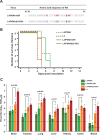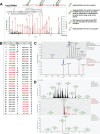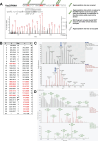Deglycosylation and truncation in the neuraminidase stalk are functionally equivalent in enhancing the pathogenicity of a high pathogenicity avian influenza virus in chickens
- PMID: 39950775
- PMCID: PMC11915841
- DOI: 10.1128/jvi.01478-24
Deglycosylation and truncation in the neuraminidase stalk are functionally equivalent in enhancing the pathogenicity of a high pathogenicity avian influenza virus in chickens
Abstract
Influenza A viruses with fewer amino acids in the neuraminidase (NA) stalk domain are primarily isolated from chickens rather than wild ducks, indicating that a shortened NA stalk is considered an adaptation marker of avian influenza viruses (AIVs) to chickens. Experimental passages of an H7N7 nonpathogenic AIV (rgVac2-P0) in chickens resulted in a highly pathogenic variant (Vac2-P3L4) with a 34-amino-acid deletion in the NA stalk, encompassing five potential N-glycosylation sites. To investigate how amino acid truncation and deglycosylation in the NA stalk contribute to increased pathogenicity, a virus with glycosylation-deficient mutations at these sites (rgVac2-P3L4/P0NAΔGlyco) was constructed. Contrary to expectations, chickens inoculated with rgVac2-P3L4/P0NAΔGlyco exhibited variable clinical outcomes, attributed to the genetic instability of the virus. A single mutation stabilized the virus, and the mutant (rgVac2-P3L4/P0NAΔGlyco-Y65H) resulted in higher pathogenicity compared with a virus with restored glycosylation (rgVac2-P3L4/P0NA-Y65H). Glycan occupancy analysis revealed 3-4 glycans at the five potential sites. In functional analysis, glycosylation-deficient mutants, similar to the short-stalk NA virus, showed significantly reduced erythrocyte elution activity. Additionally, mutational analysis indicated variable contributions of N-glycans to elution activity across the sites. Moreover, the functionally most contributing sites of the five potential N-glycosylation motifs were consistently included in the amino acid deletions of the stalk-truncated NA in N7-subtyped field isolates, despite the varying truncation position or length. These findings suggest that the loss of glycosylation is functionally equivalent to a reduction in amino acids, and it plays a crucial role in enhancing pathogenicity in chickens and affecting NA function.IMPORTANCEAvian influenza poses significant economic challenges to the poultry industry and presents potential risks to human health. Understanding the molecular mechanisms that facilitate the emergence of chicken-adapted avian influenza viruses (AIVs) from non-pathogenic duck-origin influenza viruses is crucial for improving AIV monitoring systems in poultry and controlling this disease. Amino acid deletions in the neuraminidase (NA) stalk domain serve as one of the molecular markers for AIV adaptation to Galliformes. This study highlights the critical role of N-glycosylation in the NA stalk domain in the pathogenesis of high pathogenicity avian influenza viruses in chickens. The findings propose a novel theory that the loss of glycosylation at the NA stalk domain, rather than a reduction in stalk length, is responsible for both NA function and increased virus pathogenicity in chickens.
Keywords: N-glycosylation; high pathogenicity avian influenza virus; neuraminidase; pathogenicity; site-specific glycan occupancy.
Conflict of interest statement
The authors declare no conflict of interest.
Figures







References
-
- Walker PJ, Siddell SG, Lefkowitz EJ, Mushegian AR, Adriaenssens EM, Alfenas-Zerbini P, Davison AJ, Dempsey DM, Dutilh BE, García ML, et al. . 2021. Changes to virus taxonomy and to the International code of virus classification and Nomenclature ratified by the International committee on taxonomy of viruses (2021). Arch Virol 166:2633–2648. doi:10.1007/s00705-021-05156-1 - DOI - PubMed
MeSH terms
Substances
Grants and funding
- 23KJ0059/MEXT | Japan Society for the Promotion of Science (JSPS)
- JPMJSP2119/MEXT | Japan Science and Technology Agency (JST)
- 1801/Ministry of Education, Culture, Sports, Science and Technology (MEXT)
- JP233fa627005/Japan Agency for Medical Research and Development (AMED)
- JP24wm000125008/Japan Agency for Medical Research and Development (AMED)
LinkOut - more resources
Full Text Sources
Medical
Research Materials

